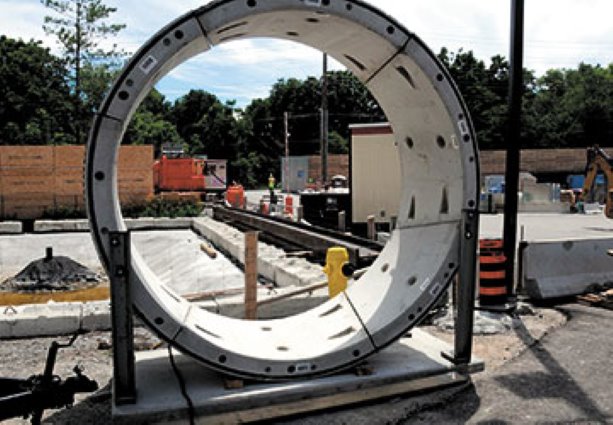Under construction since August 2011, the excavation and installation of York Region’s $550 million southeast collector trunk sewer is now swinging into high gear.
Strabag Inc., the Vienna-based design / build contractor which built the Niagara Tunnel at the Sir Adam Beck generating station in Queenston will use a total of four Caterpillar tunnel boring machines to complete the project.
Two machines are on site, a third is being commissioned and fourth will be delivered sometime in October, says regional project manager Tomislav Hrkac.
There will be 13 different shafts “although 60 per cent of the work will be done from one shaft.”
Designed to provide extra capacity and act as a relief line to the region’s only other trunk sewer, the 15-kilometre- long, three-metre (internal) diameter line is being built in a south-easterly direction from the 9th Line and Highway 407 in Markham to the intersection of Finch Avenue and Valley Farm in Pickering.
“Much of the line follows a hydro corridor,” says Hrkac, explaining the alignment was chosen to avoid dewatering problems and to minimize impact on environmental areas.
More than10 years of design, planning and environmental studies by the region and its consultants were invested into the project before construction even started, he says.
Considerable planning and upfront production work was also conducted by Armtech, the Ottawa-based material supplier.
In April of this year, it completed an almost two-year production of the 12,500 concrete rings that will be needed to form the line.
There are segmental pieces to each ring and those pieces are stacked on pallets for eventual delivery to the site, says finance and operational support manager John Ackehurst.
“We are capable of producing 36 rings per day or approximately 720 per month. Typically, we would want to be two to three months ahead of the installation process.”
To meet its target, the Ottawa plant operated two shifts daily. Each shift produced 18 rings or a total of 36 rings per day.
At present, Armtech is sending approximately five trucks weekly to the site, with each truck transporting five rings, says Ackehurst.
“When all four tunnel boring machines are online we will be running with six a day, five days a week.”
Although there were some initial start-up hurdles, the production process went fairly smoothly.
The real challenge was securing adequate storage for all 12,500 rings, as every 1,000 rings take up about one acre of space. Another major challenge was maintaining adequate temperatures during the winter in the curing tent, says Ackehurst.
The main bulk of the sewer will be completed by September 2014, although there will some carry over work into 2015, says York Region’s Hrkac.



Recent Comments
comments for this post are closed